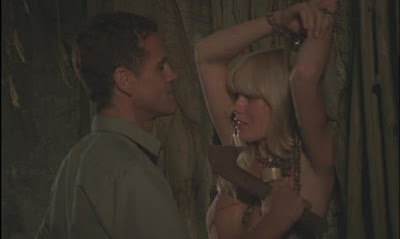It’s rare that I review a DVD / Blu-ray extra as a separate piece, but I think this is a special case. Besides, while it’s available in this country as a special bonus feature on 88 Films’ CASTLE FREAK disc, horror fans stateside have to fork out separately if they want to see it (and that's the US DVD cover opposite).
For those who don’t know, THE EVIL CLERGYMAN is one of three half-hour pieces prepared for an aborted Charles Band project called PULSE POUNDERS. The other two segments were intended as sequels to two of his successful productions of the time, namely TRANCERS and THE DUNGEONMASTER, with EVIL CLERGYMAN capitalising on the success of REANIMATOR by casting that movie’s two leads in another H P Lovecraft adaptation. Although the source material is ostensibly HPL’s, THE EVIL CLERGYMAN actually comes across a bit like Charles Band trying to imitate one of the BBC’s MR James GHOST STORIES FOR CHRISTMAS adaptations, albeit with Barbara Crampton’s bottom and a talking rat (this is Charles Band, after all).
A young woman (Barbara Crampton) arrives at the house of her dead lover (Jeffrey Combs), wanting to spend one more night in the place where they met so many times when he was alive. The interior set looks like something out of a Roger Corman Poe picture and there’s a wizened old housekeeper to match. She berates Crampton with some choice Dennis Paoli dialogue before leaving her to a night in which she will discover that her lover died under rather strange circumstances. Before he did, however, he caused the death of others, including a Bishop played by David Warner (“from Canterbury”) who was sent to perform the C of E version of excommunication on naughty Jeffrey.
It all appears to be the fault of a pesky talking rat-familiar-thing, who appears to Barbara and tries to talk her into killing herself. The rat is played by David Gale, and anyone remembering his towering presence from Stuart Gordon’s REANIMATOR will appreciate the amount of work that’s gone into building outsize sets for David-Gale-in-a-massive-rat-costume to act against, including a large mockup of Ms Crampton’s naked bottom.
Because all the footage of PULSE POUNDERS was “lost” THE EVIL CLERGYMAN only exists as a VHS master, which is painfully evident here. However, anyone who yearns for a bit of 1980s video-style nostalgia will get a kick out of this, as well as the chance to see some choice horror actors of the era (Combs, Crampton, Warner and Gale) doing their best with a decent Dennis Paoli script. Richard Band has composed a new music score for the film and it’s spot on, evoking a sense of 1980s horror while at the same time giving this short a timeless, melancholic feeling. Even director Charles Band manages a few stylistic flourishes that add to the enjoyment of this little piece.
 So many ‘lost’ films turn out to be disappointing, but THE EVIL CLERGYMAN is actually rather good. It’s as faithful to Lovecraft as you would expect from people who have given us movies like FROM BEYOND, so don’t expect a literal adaptation. In fact I’m tempted to consider CASTLE FREAK as the extra on my 88 Films Blu-ray as I enjoyed THE EVIL CLERGYMAN a lot more, and its definitely the one I’ll be watching a few more times in the future.
So many ‘lost’ films turn out to be disappointing, but THE EVIL CLERGYMAN is actually rather good. It’s as faithful to Lovecraft as you would expect from people who have given us movies like FROM BEYOND, so don’t expect a literal adaptation. In fact I’m tempted to consider CASTLE FREAK as the extra on my 88 Films Blu-ray as I enjoyed THE EVIL CLERGYMAN a lot more, and its definitely the one I’ll be watching a few more times in the future.



















